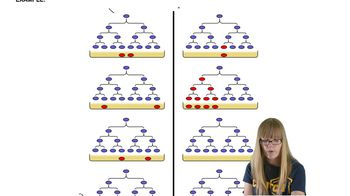Table of contents
- 1. Introduction to Genetics51m
- 2. Mendel's Laws of Inheritance3h 37m
- 3. Extensions to Mendelian Inheritance2h 41m
- 4. Genetic Mapping and Linkage2h 28m
- 5. Genetics of Bacteria and Viruses1h 21m
- 6. Chromosomal Variation1h 48m
- 7. DNA and Chromosome Structure56m
- 8. DNA Replication1h 10m
- 9. Mitosis and Meiosis1h 34m
- 10. Transcription1h 0m
- 11. Translation58m
- 12. Gene Regulation in Prokaryotes1h 19m
- 13. Gene Regulation in Eukaryotes44m
- 14. Genetic Control of Development44m
- 15. Genomes and Genomics1h 50m
- 16. Transposable Elements47m
- 17. Mutation, Repair, and Recombination1h 6m
- 18. Molecular Genetic Tools19m
- 19. Cancer Genetics29m
- 20. Quantitative Genetics1h 26m
- 21. Population Genetics50m
- 22. Evolutionary Genetics29m
17. Mutation, Repair, and Recombination
Types of Mutations
Problem 23a
Textbook Question
Textbook QuestionThe fluctuation test performed by Luria and Delbrück is consistent with the random mutation hypothesis. Briefly describe their experiment and identify how the results match the prediction of the random mutation hypothesis. What would have to be different about the experimental results for them to agree with the prediction of the adaptive mutation hypothesis?
 Verified Solution
Verified SolutionThis video solution was recommended by our tutors as helpful for the problem above
Video duration:
4mPlay a video:
Was this helpful?
Key Concepts
Here are the essential concepts you must grasp in order to answer the question correctly.
Random Mutation Hypothesis
The random mutation hypothesis posits that mutations occur randomly and independently of an organism's exposure to environmental pressures. This means that genetic changes arise without any foresight or adaptation to specific challenges, such as antibiotic resistance. In the context of Luria and Delbrück's experiment, this hypothesis predicts that the number of resistant mutants in a bacterial population would vary widely, reflecting the randomness of mutation events.
Recommended video:
Guided course

Point Mutations
Luria and Delbrück Experiment
Luria and Delbrück conducted a series of experiments using E. coli to test the random mutation hypothesis. They exposed bacterial cultures to a bacteriophage and observed the emergence of resistant mutants. Their results showed a significant variation in the number of resistant colonies across different cultures, supporting the idea that mutations occurred before exposure to the phage, rather than as a direct response to it.
Recommended video:
Guided course

Mendel's Experiments
Adaptive Mutation Hypothesis
The adaptive mutation hypothesis suggests that mutations can occur in response to environmental stressors, allowing organisms to adapt more effectively to their surroundings. If Luria and Delbrück's results had shown a consistent pattern of resistance that correlated with exposure to the bacteriophage, it would indicate that mutations were not random but rather a directed response to the selective pressure, thus supporting the adaptive mutation hypothesis.
Recommended video:
Guided course

Spontaneous Mutations

 9:49m
9:49mWatch next
Master Point Mutations with a bite sized video explanation from Kylia Goodner
Start learning


